9 Things to Know About Wilderness First Aid
Here’s how to Be Prepared to treat injuries and ailments in the backcountry.
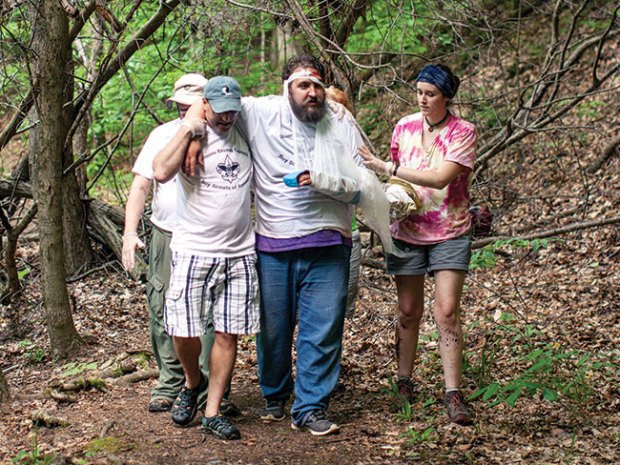
During a wilderness first-aid course, instructors will present participants with mystery injuries. It’s up to the participants to figure out what to do next.
What Is Wilderness First Aid?
If your unit is planning a remote adventure, you need wilderness first aid.
If you’d like to Be Prepared to help out your community after a major disaster, you need wilderness first aid.
The BSA’s wilderness first aid (WFA) curriculum focuses on prevention, assessment and treatment for an ill or injured person in an environment where professional medical care is an hour or more away.
“You could easily be three hours away from professional medical help,” says Luke Brewster from Troop 325 in Grand Rapids, Ohio. “Now you can do what you need to do to help.”
At Camp Lazarus in Delaware, Ohio, Luke and other members of Troop 325 took a WFA course offered by the Simon Kenton Council that follows the BSA curriculum. The troop had a high-adventure trip coming up on its calendar, and the Scouts wanted to be ready for anything.
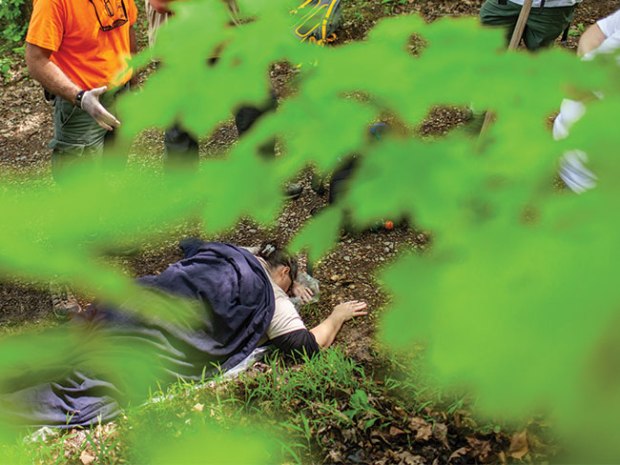
Rescuers prepare a plan to help an instructor who’s pretending to have slipped and fallen.
First, Size Up the Scene
If you come across an injured person, take a few moments to stand back, survey the scene and do a safety check. Are there clues suggesting what happened? Is it safe for you to approach the victim?
Try to gather information from the patient. Ask something like, “Can you tell me who you are and what happened?” How was the patient injured?
During the Simon Kenton WFA course, students are presented scenes of “actors” with fake injuries.
“They put us in a scenario with many different ‘victims’ to see how we would handle it,” says Blake Litz, 16, also from Troop 325. “We had to piece together what happened.”
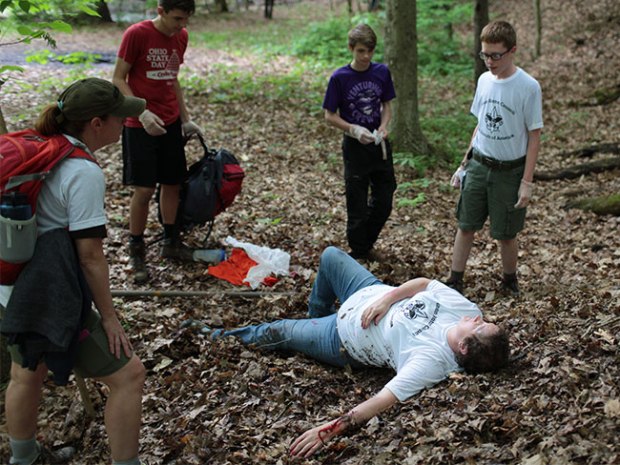
Scouts prepare to perform first aid on an instructor who is pretending to be injured.
Then, Do an Initial Assessment and Than a Hands-on Exam
An initial assessment checks for urgent medical issues, like severe bleeding or breathing problems. Treatment for issues like these requires immediate care.
Don’t forget to protect yourself from infectious diseases by donning personal protective equipment like disposable gloves, goggles, etc.
Once these concerns have been either resolved or are determined not to be a problem, a hands-on exam is the next step in determining what is wrong with the patient. It involves checking the patient from head to toe. Ask where it hurts and if it hurts when touched. Be aware of unusual behavior, such as coughing.
A patient’s vital signs can tell you how they are doing. Changes over time are indicators of changes in the condition of your patient. Check things like heart rate and respiratory rate — and keep checking regularly.
Write down the time and the results so you can track any changes. And while you’re doing all this, remember to stay calm.
“You have to focus on what’s at hand,” says Logan Smith, 14, from Troop 417 in Columbus, Ohio. “Just focus on what you’re performing.”
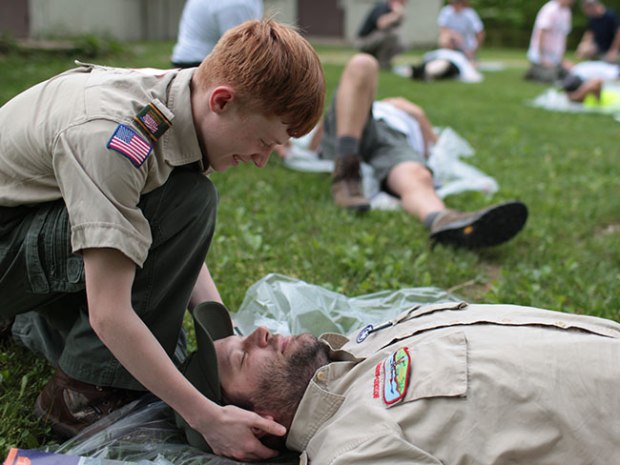
A Scout assesses the status of his father, who is pretending to be injured.
Treating Chest Injuries
Any significant injury to the chest might lead to difficulty breathing, a potentially serious and life-threatening problem. Pain is usually present, and the patient might complain of pain when taking a deep breath.
Increased difficulty in breathing usually indicates the injury is becoming worse. Any patient who has sustained a chest injury associated with increasing difficulty in breathing must be evacuated quickly.
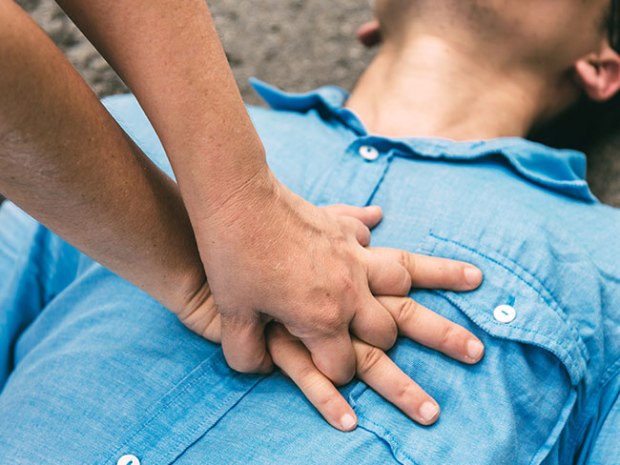
How to Handle Shock and Heart Attack
Shock is a condition in which the patient’s brain and body aren’t getting enough oxygen. It can occur from a great variety of injuries and illnesses, but the signs and symptoms are similar.
Patients in shock might appear anxious, have a rapid and weak heart rate, take rapid and shallow breaths, and appear pale with cool and clammy skin.
Shock can kill, so it’s important to treat it quickly. Keep the patient warm, calm and lying down. Raise their feet up to 12 inches as long as the patient doesn’t have any spinal, pelvic or leg injuries. Don’t do it if it causes the patient any pain.
Heart attack patients might complain of heaviness; crushing or squeezing pain in the chest; pain radiating to the left arm, shoulder, back or jaw; nausea or vomiting; shortness of breath; severe sweating (without exertion); lightheadedness or dizziness. If any of these symptoms appear and a heart attack is suspected, Be Prepared to perform CPR. Give them an aspirin to chew unless they are allergic or there is any other reason not to.
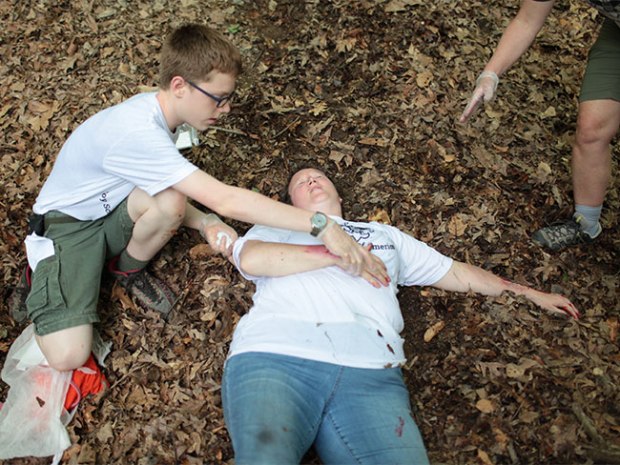
A Scout treats an “injured” hiker.
Treating Head and Spine Injuries
A period of unconsciousness during which the patient does not respond to aggressive stimulation might indicate serious brain damage.
It’s important to establish and maintain an airway in all unconscious patients.
Moving a spine-injured patient must only be performed when absolutely necessary, and proper planning must be in place to decrease unnecessary movements.
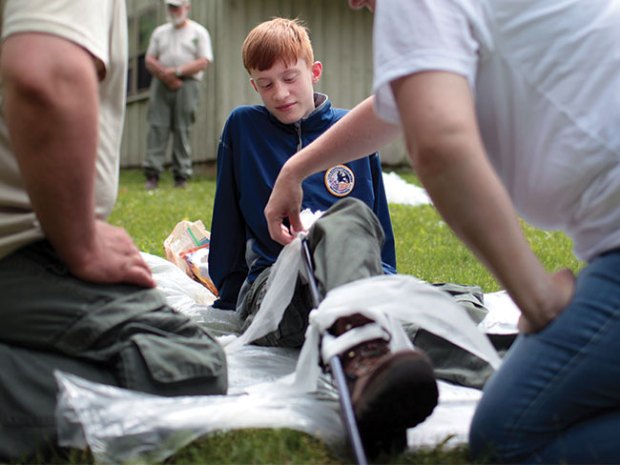
Bone and Joint Injuries
Muscle and joint injuries can range from mildly annoying to debilitating. They are indicated by pain — and sometimes by swelling and bruising — in the area of the injury.
Immobilization may lessen pain. Applying ice or a cold pack can help reduce swelling and ease pain. Elevate the injured area above heart level to reduce swelling, and always make sure there is a thin layer of fabric between the ice pack and the skin.
A broken bone might be obvious. If it isn’t, take a look at the site of the injury. Is there discoloration and swelling? Does the patient move the injured area easily or prevent motion? Compare the injured side to the uninjured side. Does it look different?
A splint can restrict movement of the broken bone, which might prevent further injury and help the patient be more comfortable until a medical facility can be reached.
During a WFA training course, you might have to question an “injured” person to determine the best treatment.
“Some people would be lying on the ground, and they would tell us their injuries, and we would treat them with the materials we had on us,” says Toby Dush, 15, from Troop 16 in Columbus.
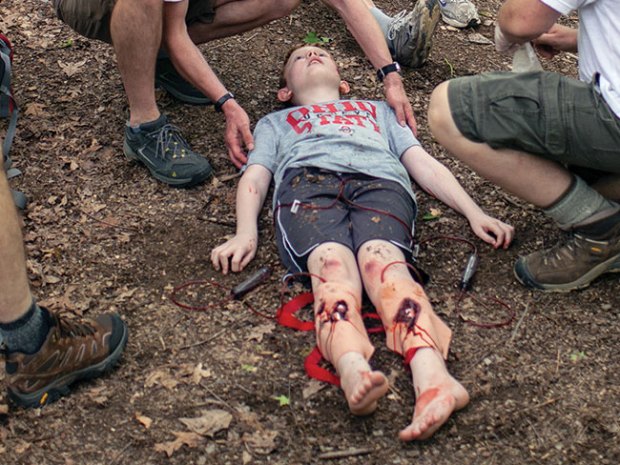
The injuries might look bad, but it’s really just makeup used at the Simon Kenton Council training course.
Wounds and Wound Infection
The best method for cleaning a wound is irrigation. It involves directing a stream of disinfected water — or at least drinkable water — into the wound to wash it out.
You can use a water bottle or punch a pinhole in a clean plastic bag. Wounds that are large, deep or very dirty, such as an animal bite, will need immediate advanced medical care after initial treatment.
A dressing is the primary covering of a wound.
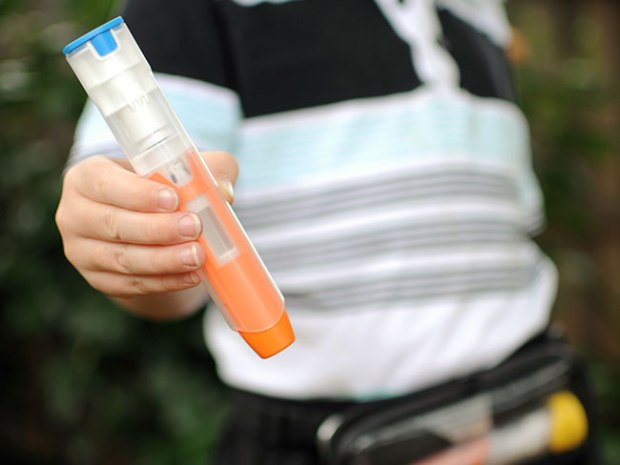
Allergies and Anaphylaxis
Allergic reactions can come from foods, drugs, pollen, bugs and plant oils. A severe reaction, known as anaphylaxis, is a true emergency. Swelling of the face,
lips and tongue is common. Anaphylaxis can lead to extreme difficulty breathing and death if not immediately treated.
Anaphylaxis is reversible only by an immediate injection of epinephrine. Injectable epinephrine is available by prescription only in spring-loaded syringes that are pressed into the thigh.
All of this can be intimidating to the untrained Scout. One of the most important aspects of providing first aid is keeping your cool despite the situation in front of you.
“If something occurs, hopefully I’ll be able to stay calm,” says Will Ray, 14, from Troop 474 in Columbus. “Now that I know what to do, I can go into more depth in helping.”
Where Do I Sign Up?
Adults and youth 14 years and older can become BSA wilderness first-aid certified. Upon completion, the certification is good for two years. By participating in classes, participants will learn how to assess, treat and — when possible — keep emergencies under control within the scope of their training.
Contact your local council for WFA training near you. There are also courses available through the American Red Cross and the Emergency Care & Safety Institute (ECSI) that follow the BSA WFA curriculum.
Learn more at go.scoutlife.org/wfa.
Leave a Comment